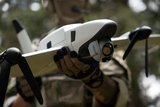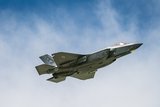Polish anti-A2AD system blends ISR and strike capabilities
The FT-5 UAV is one element of the W2MPIR anti-A2AD system. (Photo: WB Group)
A new anti-A2AD concept from Polish manufacturer WB Group offers the prospect of loitering munitions or armed UAV swarms waiting in the sky to strike their target when called upon.
First showcased at the MSPO event in Kielce on 7-10 September, W2MPIR is designed to help overcome tiered air defence systems by employing soft- and hard-kill technologies against adversary EW and SIGINT systems, interfering with radar, GPS signals, data link communications and navigation systems.
By fusing the Topaz battle management system with low-cost autonomous precision weaponry such as Warmate 1 and the newer Warmate 2 loitering munition, as well as its FlyEye and FT-5 tactical reconnaissance UAVs, WB Group claims that W2MPIR adds information advantage to strike advantage.
Warmate 2 is larger than its predecessor with a heavier 5kg warhead (compared with 1.4kg on Warmate 1) and 2h endurance. Using a forward operator, its range of operation is 30-240km. Warmate 2 uses catapult launchers on 4x4 vehicles.
FlyEye can provide imagery and electromagnetic (EM) spectrum recognition at a range of 50km without signal retranslation, while the FT-5 is capable of longer-distance reconnaissance and surveillance at 180km without retranslation.
According to WB Group VP Adam Bartosiewicz, swarms of Warmates would saturate enemy A2AD installations but the attritable loitering munition can also be employed to detect RF emissions from high-value targets.
‘In my opinion, in future conflicts the winner will gain dominance… in communication ability and will avoid detection and jamming,’ said Bartosiewicz. ‘In the electronic warfare environment situation awareness will be limited to knowledge about which systems and which method is jammed.’
One notable feature of the CONOPS for W2MPIR is its use of Warmate as an on-demand strike capability. Warmates would be launched in advance to wait above selected areas of the battlefield (they can remain in position for up to 70min).
With this ‘aerial storage’, as WB Group describes it, troops on the ground can call on Warmate when needed by using U-Gate terminals (also made by WB Group) at ranges of up to 30km. Tests have shown that a single operator can effectively control up to ten Warmates simultaneously for coordinated attacks.
W2MPIR can also operate alongside traditional artillery methods, said Bartosiewicz, but he added that small UAVs such as FlyEye or Warmate loitering munitions have the advantage of being able to get close to adversary EW systems and ‘play using the opponent’s power’ – in other words, use the strong EM emissions from jamming systems for guidance without directly relying on GPS.
Related Equipment in Defence Insight
More from Air Warfare
-
![Bell advances to next stage of US Army’s aviator training programme competition]()
Bell advances to next stage of US Army’s aviator training programme competition
The US Army plans to award a contract through its Flight School Next competition to replace its UH-72A Lakota by late 2026.
-
![Spain moves ahead with transport, intelligence and training aircraft modernisation efforts]()
Spain moves ahead with transport, intelligence and training aircraft modernisation efforts
Confirming its C295 order in late December, the Spanish Ministry of Defence also awarded Airbus with its Hurjet procurement contract and both Airbus and Indra with a contract to investigate a proposed Signals Intelligence aircraft solution by 2028.
-
![December Drone Digest: Germany, Australia and US champion indigenous UAV production]()
December Drone Digest: Germany, Australia and US champion indigenous UAV production
One of the key trends seen in December has been the rise in indigenous investment within the UAV market, particularly across certain countries, with Germany, Australia and the US focusing on their commitments to sovereign development.
-
![What might next-generation military aircrew training look like?]()
What might next-generation military aircrew training look like?
Changing roles for combat aircraft fleets, the rise of simulation and LVC technologies, and the increasing cost of flight hours could all be leading to a paradigm shift in military pilot training.
-
![2025 air market review: European defence independence, next-gen tech and export concerns dominate]()
2025 air market review: European defence independence, next-gen tech and export concerns dominate
This year’s (geo)political turmoil has challenged many long-prevailing assumptions, leading to far-reaching consequences for air forces and their supplier bases in industry worldwide – with five key trends in review for 2025.
























